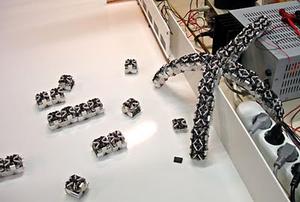UAV updateEnhancing communication of swarming robots
With the help of computer simulations and prototypes, researchers are striving to enhance the communication in human and multi-robot interactions

Robot swarm coordinating to complete a complex task // Source: gadgetcage.com
It would be nice if each household had an electronic helper or if robots could fulfill the tasks that are too dangerous or troublesome for humans. Things that are taken for granted in movies such as the “Bicentennial Man” or “I-Robot” are still futuristic scenarios in reality.
Paolo Robuffo Giordano investigates the fundamental aspects necessary for the relevant technical development at the Max Planck Institute for Biological Cybernetics in Tübingen, Germany. He and his team mainly work with flying multi-robot systems, which receive instructions from a human user and are then able to fulfill the details of the task autonomously.
Robuffo Giordano is the project leader of the Human Robot Interaction Group in the Department Human Perception, Cognition and Action of Heinrich Bülthoff at the MPI for Biological Cybernetics. His team works with quadrocopters, small flying robots referred to as UAVs.
Navigated by a human operator, four or more of these UAVs, which are approximately forty cm in diameter, perform local tasks maintaining a programmed, spatial configuration.
A Max-Planck-Gesellschaft release reports that if the UAVs are instructed to fly forward in a programmed formation, they do so while avoiding obstacles autonomously. While flying, the robots provide the human operator with sensory feedback — visual, proprioceptive, tactile and auditory, depending on the equipment and programming, which maximizes the operator’s awareness. If an object is in the way, the control will be aggravated in that specific direction until the robots have overcome the obstacle.
“It’s like actually flying against a wall,” Robuffo Giordano explains. The robots autonomously keep track of each other using cameras and regulate their position in relation to one another. The human operator can track the UAVs on his monitor.” We are investigating some fundamental aspects of these topics, which are necessary for any possible future applications,” the scientist explains.” The development and programming of such robots is mainly an application of mathematical theories. That’s why we see ourselves as engineers.”
The release notes that, furthermore, the researchers are also investigating the interactions between remote multiple robots in multi-robot systems and a human operator in order to enhance communication. Some aspects of such multi-robot systems mimic the movement of swarms of birds. This scenario becomes important when modeling big formations in computer simulations, in which the robots do not keep a defined distance to one another, but always need to keep in sight of another robot within the formation.
The results of the fundamental research done by Robuffo Giordano’s team can be applied in various areas. It is possible, for example, to attach a hand to one or more of the quadcopters and through this to interact with and grasp objects as if the operator’s hands have an unlimited range. Likewise, robots can be equipped with various sensors to collect different environmental data. They can convey the information to a computer or a human operator.” These robots might be an extension of our own senses,” says Robuffo Giordano.. Using this approach, unknown or potentially dangerous areas can be explored without endangering any humans. Still in the field of the imagination lie applications in the medical field, where doctors deploy teams of nano robots inside the human body to examine and treat at exact locations.
